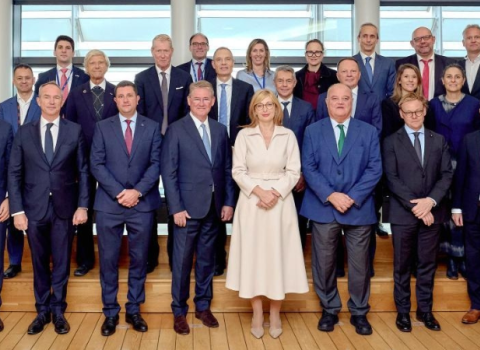
The game plan is to piggyback the spotlight provided by this summer’s World Cup to remind us that the country is not only home to footballing gods Klinsmann, Beckenbauer and Ballack, but also the birthplace of scientific superstars like Einstein, Fahrenheit and Hertz.
Alongside the football tournament, Germany is showcasing itself as the “Land of Ideas”, a theme that is exemplified by a display in Berlin of oversize sculptures of German inventions. The timeliest sculpture is of cleated football boots, first developed in Bavaria in the 1920s by Adi Dassler, founder of the eponymous sportswear company Adidas.
As of now, Germany’s focus on science starts at the top. The new chancellor, Angela Merkel, says the keys to prosperity are research, innovation, science and development. An innovation herself as her country’s first female leader, she holds a PhD in physical chemistry. The new leader of the other party in the coalition government, Matthias Platzeck, is also steeped in science. He studied biomedical cybernetics.
Speaking in Hanover this month at the opening of CeBIT, the world’s largest IT exhibition, Merkel fleshed out her ambitions to grow Germany’s high tech sectors and announced the staging of a “national IT summit”.
Backing up these initiatives, the federal government has pledged an extra €6 billion for R&D in the current legislative period, making its R&D funding “greater than ever before”, according to Annette Schavan, the education and research minister. The government wants to increase R&D spending from 2.49 per cent of GDP annually to 3 per cent by 2010 – in line with the European Union’s Lisbon target
Starting strong
Germany started from a strong position, with an R&D to GDP ratio of 1.9 per cent in 2004, well above the EU average, according to Eurostat, the EU’s statistical office. It trailed Sweden at 3.74 per cent, Finland 3.51 per cent and Denmark 2.63 per cent.
Perhaps more significantly in terms of global competitiveness, it was behind the United States at 2.67 per cent and Japan 3.63 per cent. But it is important not to overdo the gloom: apart from boasting Europe’s largest economy, and the third largest in the world, Germany is also the world’s leading exporting nation, and one of the few developed economies to have a trade surplus.
An additional €4 billion for R&D is to come from Germany’s 16 state governments, with industry expected to kick in €20 billion more. Industry is the biggest R&D player by far, spending €36.8 billion in 2003. The other two R&D sectors, universities and research institutes (primarily the Max Planck Society and the Fraunhofer-Gesellschaft), spent €9.1 billion and €7.3 billion, respectively.
The numbers are impressive, but hanging over this investment is the spectre of the technology bust of 2000 – 2002. Promotion of science-based industry – particularly biotechnology, IT and software – took off in Germany in the mid-1990s with the creation of numerous public venture capital and technology transfer programmes financed by soft grants.
The prime example is the BioRegio competition launched in 1995 to generate biotechnology clusters, and challenge the UK’s dominance of the biotech sector in Europe. Winning regions received federal funds to match private investment in biotech start-ups.
Hundreds of “new economy” start-ups were founded. With the backing of many small retail investors, prices soared on the German Nemax (Neuer-Markt-Index), Europe’s most active stock exchange for technology shares. When the tech bubble burst in 2000, the shakeout was severe, and Nemax sank without a trace in 2002.
Since then, the shortcomings of throwing soft money at start-ups have come under sharp scrutiny. Critics pointed out that beneficiaries often fail when subsidies cease, and taxpayers foot the bill.
Reflecting the shift in thinking, the new government’s “High-Tech Strategy for Germany” emphasises competitive tax conditions for private venture capital, improved debt-financing terms for small- and mid-size companies, and a more modern law on private equity companies.
The Anglo-Saxon challenge
The goal – in the words of Michael Glos, the economics minister – is to give “new, innovative businesses” financing opportunities “at least as good as in Anglo-Saxon countries”.
Pressed by ascendant economic rivals like China, India and the new EU members in Eastern Europe, Germany “must achieve competitive advantages primarily by permanent innovation, so that we’re better to the degree that we’re more expensive” –says the coalition agreement setting out the new German government’s policies.
Holger Frommann, managing director of the Berlin-based German Private Equity and Venture Capital Association, believes the planned measures point in the right direction, “particularly those in the area of early-stage financing that go beyond the existing subsidy structure.”
While investments by German private equity companies fell by 19 per cent in 2005 compared with the previous year, the last two quarters saw a strong upward trend. German private equity funds raised 45 per cent more than in 2004, equivalent to €2.9 billion – nearly half of it in the fourth quarter.
Christoph Ringwald, spokesman for the Berlin IT company Pixelpark (2004 sales: €18.2 million), also senses a “more favourable” R&D climate in Germany. “We plan to spend more on research and development this year – partly because of assistance programs that didn’t previously exist,” he says.
Germany’s “innovation chancellor”
Some current innovation initiatives were started during the tenure of Gerhard Schröder (1998-2005), who liked to see himself as “the chancellor of innovation”. While his efforts were undercut by budgetary constraints, he succeeded, at great political cost, in pushing through a reform programme, dubbed Agenda 2010. This aims to revitalise the economy by unfettering Germany’s regulation-bound labour market, trimming its cushy social welfare system and lowering taxes.
Passed in diluted form in 2003, the programme was nevertheless a sea change in a society whose rigidity and play-it-safe ethos have held back innovation.
It came at the nadir of the crisis of confidence afflicting Germans, still groaning under the burden – financial and social – of reunification. Accustomed to thinking of their country as “the land of poets and thinkers”, they were stunned by a miserable showing in an international study of scholastic aptitude. The ambitious autobahn toll system had become a glitch-riddled joke. Even Mercedes-Benz was down in quality ratings.
Referring to Germany’s feel-good “Land of Ideas” campaign in her speech opening this year’s World Economic Forum, Merkel said: “We can’t live from ideas alone. We’ve got to show that we can put them into practice too.”
But technology transfer is German R&D’s weak link. MP3 music technology is perhaps the best-known contemporary case of German ingenuity that became a money-making product elsewhere. The fax machine is another.
Bernd Wirsing, press officer at the Max Planck Society, notes that basic German research is first-class, with the citation rate of German scientists third in the world behind Americans and Britons. Meanwhile Germany is top of the rankings in patents for inventions that improved existing products. “The problem,” Wirsing said, “is with patents for breakthrough innovations.”
Traditionally, science and commerce have kept to their separate spheres; experienced scientists are generally unwilling to leave established jobs to work in start-up companies, and lack oversight by venture capitalists. Financiers are tight-fisted if they’re not certain of success.
German society is seen as risk-averse and change-resistant. “There’s a certain scepticism towards everything new,” said Wirsing, who noted that the Max Planck Society earned fully half of its licensing revenue outside Germany.
Regional clusters
To mix the two halves of science and commerce, Germany is forming regional “innovation clusters” of universities, research institutes and companies in selected areas of research. It is also slowly reforming its educational system, which the Berlin-based German Institute for Economic Research (DIW) recently named as one of the country’s chief weaknesses.
German scientists, discouraged by prospects at home, leave for universities and research institutions abroad. Some 20,000 young German researchers now work in the United States, where three-quarters of German-born Nobel Prize laureates pursued their professional careers.
Last year, a group of 160 scientists working in North America sent an open letter to top German education officials listing conditions for their return, including establishment of a tenure track, more flexible occupational structures, and transparent and unimpeded appointment procedures.
Expect to hear a litany of excuses for the missed chances on the football pitch this summer - perhaps as many as the reasons cited for the chances fumbled on the way from laboratory to market. After all, innovation, like football, is a game of two halves.





 A unique international forum for public research organisations and companies to connect their external engagement with strategic interests around their R&D system.
A unique international forum for public research organisations and companies to connect their external engagement with strategic interests around their R&D system.